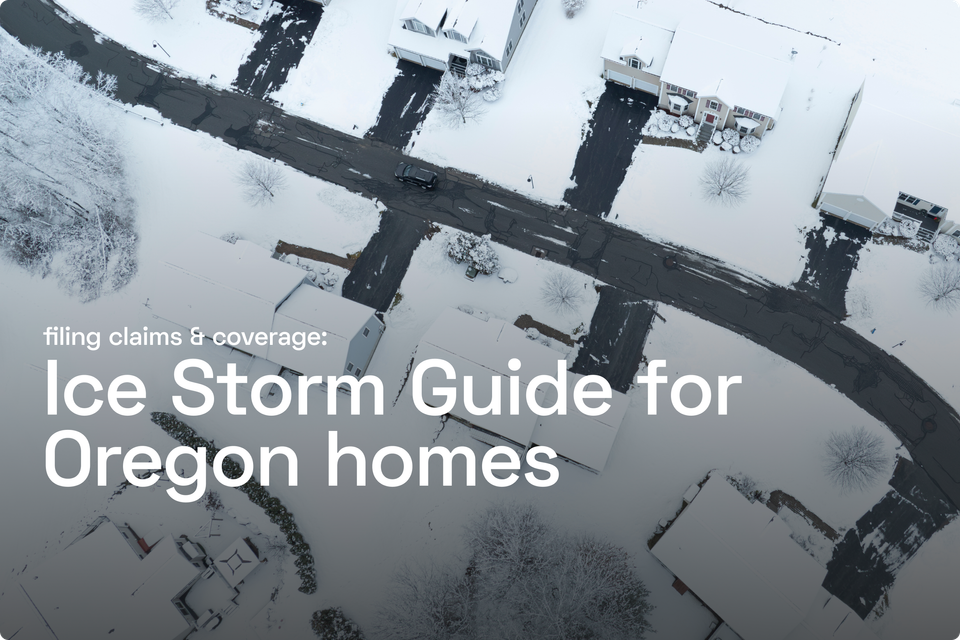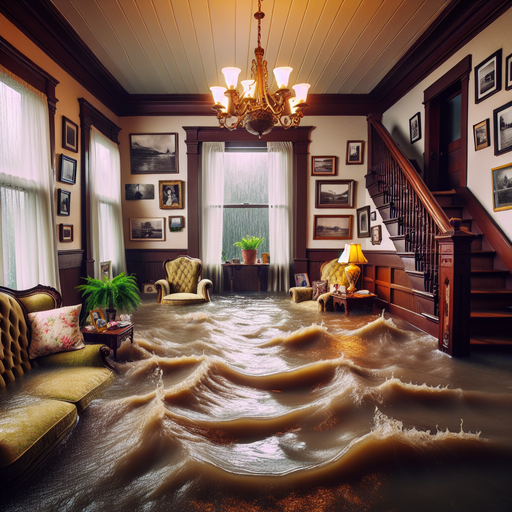Ice Storm Guide: Filing Claims & Coverage for Oregon Homes


Ice storms pose a real threat to Oregon Homes. With their icy wrath, they can wreak havoc on property and possessions, causing extensive damages that can cost homeowners thousands of dollars in repairs. Are you prepared enough to face this challenge head-on?
Let's think about it: The storms are unpredictable, and the damage is often unavoidable. But that doesn't mean you're powerless. Far from it! A robust insurance policy can help shield you from the financial impacts of ice storm damages. Besides repairing or replacing damaged property, comprehensive coverage can also cover additional living expenses if your home becomes uninhabitable.
This guide is your ultimate resource for understanding how to handle Filing Claims & Coverage during ice storm events in Oregon. We'll journey through the essential aspects of homeowners insurance, renters insurance, auto insurance, specialized coverages, flood insurance, and even how to prevent water damage from burst pipes in freezing conditions!
Ready to storm-proof your home with the right insurance coverage? Let's dive right in!
Understanding Homeowners Insurance in Oregon
Ice storms in Oregon can be devastating, causing extensive damage to your home. This is where homeowners insurance plays a critical role. It provides a safety net, covering repair costs when the unexpected happens.
Role of Homeowners Insurance
Homeowners insurance Oregon is essential to protect your home from ice storm damage. Think about this: An ice storm strikes and a tree crashes onto your roof, or freezing temperatures burst your pipes. Without insurance, you are left with hefty repair bills. But with homeowners insurance, you're covered.
Coverage Options
Understanding the coverage options provided by homeowners insurance policies can be tricky. However, it's crucial to ensure you have the right protection. Here are some common coverage types:
- Dwelling Coverage: This covers damages to your home structure due to covered perils such as ice storms.
- Personal Property Coverage: This covers damages to or theft of personal belongings within your home.
- Liability Coverage: This covers legal expenses if someone is injured on your property.
- Additional Living Expenses (ALE): In case an ice storm makes your home uninhabitable, ALE helps cover living expenses during repairs.
Filing a Successful Storm Damage Claim
Filing an insurance claim after an ice storm can feel overwhelming. Here's a simple guide:
- Document the damage: Take pictures and make detailed notes of all the damage.
- Notify Your Insurer: Inform them about the incident as soon as possible.
- Complete Claim Forms: Fill out all necessary forms accurately and promptly.
- Work With An Adjuster: They'll inspect the damage and determine how much the insurance company will pay for repairs.
Deductibles and Their Impact
Deductibles are important considerations in homeowners insurance policies. That's because they directly impact your coverage limits during ice storms. A deductible is the amount you'll pay out-of-pocket before insurance kicks in. So, for instance, if you have a $1,000 deductible and ice storm damages amount to $5,000, your insurance will cover $4,000 after you pay your deductible.
Comprehensive Coverage and the Best Homeowners Insurance
Comprehensive coverage options are a hallmark of the best homeowners insurance Oregon. Such policies provide extensive protection against a wide range of perils, including ice storms. They offer peace of mind knowing that whether it's damage from falling trees or burst pipes due to freezing temperatures, you're covered.
In summary, understanding your homeowners insurance in Oregon is key to safeguarding your home from ice storm damages. Ensure you understand the role of your policy, the different coverage types offered, how to file claims successfully, and how deductibles can impact your coverage. Remember that comprehensive coverage options are often indicative of the best homeowners insurance policies for ice storm protection in Oregon.

The Significance of Renters Insurance in Oregon
Why Renters Insurance is Important in Oregon
Ice storms are a recurring phenomenon in Oregon. While homeowners often prioritize insurance coverage for their properties, it's equally crucial for renters to have adequate protection. Renters insurance in Oregon is an often overlooked necessity that can play a pivotal role during ice storm events.
Understanding the Need for Renters Insurance
You may think, "I don't own the building, so why do I need insurance?" It’s simple. Your landlord's policy covers the building structure but not your personal possessions within the unit.
Imagine waking up after an ice storm to find your rented apartment damaged, and your belongings destroyed. Without renters insurance, you'd be responsible for replacing everything out-of-pocket.
What Does Renters Insurance Cover?
Renters insurance policies typically extend three core coverage components:
- Personal Property Coverage: This helps replace or repair personal belongings like furniture, electronics, and clothing damaged by a covered peril such as an ice storm.
- Liability Protection: If someone is injured within your rented premises or you accidentally damage someone else's property, this coverage can help with legal expenses or repair costs.
- Additional Living Expenses (ALE): If your rental becomes uninhabitable due to a covered event like an ice storm, ALE can help cover costs of temporary housing and other living expenses.
It's important to review your policy's terms and conditions carefully to ensure these coverages align with your needs.
How Renters Insurance Helps with Temporary Accommodation
When an ice storm hits and renders your rented home uninhabitable, the ALE component of renters insurance comes into play. Known also as loss of use coverage, it can cover hotel bills, temporary rentals, restaurant meals, and other expenses incurred while your rental property is being repaired.
Consider this scenario: An ice storm in Portland causes severe structural damage to your rented apartment. You're forced to move into a hotel for a week while repairs are made. With renters insurance Portland Oregon policy, your additional living expenses can be covered.
The Importance of Renters Insurance in Oregon
Renters insurance in Oregon offers crucial financial protection against ice storm damage. It's an investment in peace of mind that your personal belongings are protected and additional living expenses will be covered should the worst happen. Don't overlook its importance - the cost of replacing everything could be far greater than the cost of an annual renters insurance premium.

Auto Insurance Considerations for Oregon Residents
Ice storms in Oregon are not just a threat to homes, but they can also cause significant damage to vehicles. Your auto insurance policy is a crucial line of defense against ice storm-related damages. But how confident are you that your current coverage can shoulder the financial burden if your car suffers severe damage during an ice storm?
Review Your Auto Insurance Policy
Just like homeowners and renters insurance, your auto insurance policy contains specific coverages that relate to storm damage. Comprehensive coverage, for example, typically covers damages caused by natural disasters, including ice storms. It's essential to review your policy documents or consult with your insurance agent to confirm what perils are covered.
Key Point: Ensure you understand the details of your comprehensive coverage. Does it cover windshield cracks caused by falling ice? What about dents from hailstones? Knowing these details will give you peace of mind when an ice storm hits.
Filing An Auto Insurance Claim
When disaster strikes and your vehicle sustains damage from an ice storm, it's crucial to know how to file a successful claim. Here are the steps you need to follow:
- Document The Damage: Take photos of all visible damage before making any repairs. If possible, also take pictures of the surrounding area.
- Report The Incident: As soon as possible, notify your insurer about the incident and start the claims process.
- Complete The Claim Form: Fill out all necessary paperwork provided by your insurer accurately and completely.
- Cooperate With The Adjuster: An insurance adjuster may inspect your vehicle to assess the damage.
- Follow Up Regularly: Keep track of your claim's progress by checking in regularly with your insurer.
Remember, each auto insurance provider has its own procedures for filing claims, so it's always best to confirm with them directly.
Armed with this knowledge, Oregon residents can face the perils of ice storms with confidence. But remember, auto insurance doesn't end with securing a policy and filing claims. It's about ensuring that you have the right coverage at the right price, and that's where LUNA comes in. With LUNA, you can compare quotes from top insurers and find an auto insurance policy that offers the protection you need at a price you can afford.
Specialized Coverages for Unique Ice Storm Risks
Ice storms can leave a trail of peculiar damages in their wake, property damages and fallen trees being some of the most common. The aftermath often includes dealing with storm debris scattered across your property, potentially causing additional harm to your home or belongings.
Assessing Damage: A Crucial First Step
How do you handle this? Start by assessing and documenting the extent of the damage. This step is crucial in supporting your insurance claim. Use photographs and videos to capture detailed evidence of all affected areas. Don't forget to include any damage to outbuildings, landscaping, or other structures on your property.
Specialized Coverage Options: More Than Just Home Repair
Now you're thinking, "But what about my fridge full of food that spoiled during the power outage?" Good news! Some homeowners insurance policies offer specialized coverages like food spoilage coverage. This helps cover the cost of replacing food lost due to a power outage during an ice storm.
Here's what you need to know about food spoilage coverage:
- It's typically an optional add-on to your policy
- It usually has a lower deductible than your standard policy
- It covers perishable items stored in refrigerators or freezers that spoil during a covered power outage
So yes, you could be compensated for that freezer full of steaks and ice cream that didn't survive the storm!
Remember, not all policies are created equal. Coverage options vary by insurer and even by individual policy. Make sure you understand what's included in yours. If you're unsure, reach out to your insurance agent - they're there to help!

Preventing Water Damage from Burst Pipes in Freezing Conditions
When ice storms hit Oregon, the plummeting temperatures can wreak havoc on plumbing systems, leading to broken pipes and potential water damage in your home. Understanding how to protect your home's pipes from freezing is a crucial aspect of home maintenance during the colder months.
Home Maintenance Tips to Ward Off Frozen Pipes:
1. Insulate Exposed Plumbing
Wrap pipes in unheated areas such as basements, attics, and garages with insulation sleeves or heat tape. This extra layer of protection can be the first defense against temperature drops.
2. Seal Leaks and Drafts
Identify any drafts near pipes, especially where they might enter or exit your home. Use caulk or foam insulation to seal these leaks, keeping the warm air in and the cold out.
3. Keep a Drip Going
Allow faucets to drip slightly during extreme cold spells. The running water, even just a trickle, helps prevent pipes from freezing.
4. Maintain a Consistent Temperature
Keep your thermostat set at the same temperature day and night. While it might increase your heating bill, it could prevent a costly pipe burst home repair.
5. Open Cabinet Doors
Encourage warmer air circulation by opening cabinet doors under sinks, especially if they're located on exterior walls.
6. Drain Water Systems When Away
If you plan to be away from home for an extended period during winter, drain your water system. No

water in the pipes means no freezing and bursting.
Preventive Measures for Homeowners:
1. Emergency Plan
Have an emergency plan ready. Know how to shut off your water main and have the necessary tools at hand should you need to act quickly.
2. Professional Inspections
Consider having a professional plumber inspect your plumbing system before winter sets in. They can identify potential risk areas and suggest solutions.
Implementing these preventive measures not only protects your Oregon home from damage but also gives you peace of mind during those icy months. Stay ahead of the weather by taking action now; when Jack Frost comes knocking, you'll be ready with robust defenses against pipe bursts and water woes.
Remember, prevention is always better than cure when it comes to safeguarding your home against the ravages of a harsh winter storm season.
Does Flood Insurance Provide Adequate Coverage for Water Damages?
When ice storms hit, Oregonians might be concerned about the havoc these frozen deluges can wreak on their homes. One of the critical questions homeowners often grapple with is whether flood insurance in Oregon provides coverage for water damage stemming from burst pipes during these icy times.
Standard Flood Insurance: What's Covered?
Flood insurance policies are designed to protect homeowners from the peril of floodwaters, whether it comes from overflowing rivers or storm surges. However, here's what you need to know when it comes to burst pipes:
- Flood insurance typically covers water damage that is directly caused by a flood event, as defined by the National Flood Insurance Program (NFIP).
- A burst pipe scenario, while certainly involving water in your home, isn't usually a result of flooding from an external source—thus it's not generally covered under standard flood insurance policies.
Homeowners Insurance: The First Line of Defense
For protection against damages from burst pipes during ice storms, your homeowners insurance policy is the most likely candidate:
- Most homeowners policies include water damage coverage for incidents like a burst pipe as part of standard coverage.
- However, it’s important to read through your policy or talk to your agent to confirm this, as coverage details and exclusions can vary widely between policies and insurers.
Navigating Water Damage Coverage
To ensure you're fully protected against the financial impact of water damages:
- Review Your Policy: Check the specifics of what kinds of water damage are covered.
- Understand Exceptions: Some policies may exclude certain types of water damage or may require additional endorsements.
- Document Everything: In case of a pipe bursting due to freezing conditions, thoroughly document the damages and repairs for claims purposes.
Remember, while flood insurance in Oregon may not address all concerns related to ice storm-induced water damages such as burst pipes, having a comprehensive homeowners insurance policy could bridge that gap. And if you're ever in doubt about your coverage details or need help with understanding your policy options, don’t hesitate to reach out to insurance experts who can guide you through the nuances and ensure that you're well-equipped to handle whatever Mother Nature throws at your home.

Choosing the Best Insurer for Ice Storm Insurance in Oregon
Ice storms can cause a lot of damage to your Oregon home, so it's important to have the right insurance coverage. But how do you know which insurance company is the best choice for you?
Top Insurance Companies in Oregon
Here are three top insurance companies that offer homeowners coverage in Oregon:
- State Farm offers comprehensive policies that cover various ice storm-related damages, from fallen tree debris to burst pipes.
- Nationwide provides a unique Brand New Belongings® policy, which could be beneficial if an ice storm damages new possessions.
- USAA excels at offering coverage tailored to military members and their families, including protection against common ice storm perils.
While these companies are leaders in the market, the best insurer for you will depend on your specific circumstances.
Evaluating Insurance Providers
To gauge an insurer's reliability, turning to resources like NerdWallet rating can be invaluable. Evaluating financial strength and customer satisfaction ratings of insurers gives insights into their ability to handle claims and customer service experience.
Of course, cost will factor into your decision when choosing an insurer. While important, it shouldn't be the only consideration. Remember, low premiums might mean less comprehensive coverage—which could leave you underinsured during an ice storm.
Tips for Comparing Costs
When comparing costs, it's essential to obtain accurate home insurance quotes online. Here are a few tips:
- Ensure all information provided is accurate and up-to-date.
- Include any recent home improvements that may increase your home's value.
- Specify any special features of your home that could affect its replacement cost.
- Don't forget to consider potential ice storm damages when determining the amount of coverage you need.
A tool like LUNA: Compare Car + Home Insurance Quotes can simplify this process, allowing you to compare quotes from top insurers in one place.
So, while navigating the world of insurance can seem daunting, with the right tools and perspective, you can find a policy that offers you the protection you need against ice storms in Oregon.
Protecting your home and cherished belongings against the unpredictable wrath of ice storms in Oregon is a serious concern. With the right insurance coverage, you're not just buying peace of mind—you're investing in a safety net that stands strong when nature does its worst. Here's how to make sure you're covered:
- Stay Proactive: Always keep your insurance policies up to date. As life changes, so do your coverage needs. Got a new addition to your home? Updated your heating system? Make sure your policy reflects these changes.
- Get Savvy with Quotes: Tap into the power of technology by getting home insurance quotes online. It’s quick, convenient, and you can easily compare the cost of homeowners insurance in Oregon from the comfort of your own space.
- Seek Expert Advice: Insurance jargon can be complex, and the claims process daunting. Don't hesitate to reach out to professional insurance agents who can guide you through policy details and help ensure you make informed decisions.
Remember, it's not just about finding an affordable rate; it's about ensuring that when ice coats the streets and trees come tumbling down, your policy has got you covered without any cold surprises.
For tailored advice and competitive quotes that take the guesswork out of shopping for insurance, consider LUNA. With 24/7 expert support and easy insurer switching, finding robust coverage for everything life throws your way just got a whole lot simpler.
